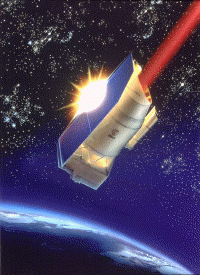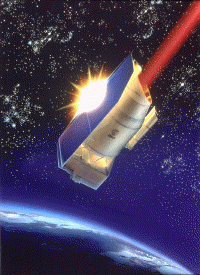The role of dust unveiled by the ISOCAM camera
 |
Our understanding of the history of the universe, or more precisely of galaxy formation, has recently been subject to an important revision. One of the ajor goals of the ISOCAM camera was to detect the light radiated by interstellar dust in the surroundings of newborn stars. After several years of observations of the sky reaching depths one thousand times larger than the previous infrared satellite, the american satellite IRAS (InfraRed Astronomical Satellite), a team from the Service d'Astrophysique of CEA Saclay has detected and confirmed a surprising discovery: the presence on the infrared images (at the wavelength of 15 microns) of nearly ten times more galaxies than predicted. |
|
Artist view of the ISO satellite |
The diffuse infrared background
It would have taken even more time for this discovery to convince the astronomical community of its truthfulness if it were not accompanied by another discovery going in the same direction: the detection of a diffuse extragalactic background in the infrared domain by a french team directed by Jean-Loup Puget (Institut d'Astrophysique Spatiale, Orsay) from the images of the sky of the american satellite COBE (COsmic Background Explorer), in the far infrared and sub-millimeter (between 0.1 and 1 millimeters). The existence of a diffuse background in the radio domain, the famous residual noise proving that the universe experienced an initial explosion, the Big Bang, is known since 1965. The cosmic infrared background, fainter and with a different spectral shape, does not originate from the Big Bang itself. The only explanation is that is results from the light radiated by galaxies since their birth until now. The question is then: was this infrared light radiated by newborn stars or by super-massive black holes, which are presently known to be so numerous that every galaxy may detain one ?
|
|
|
The diffuse infrared background (wavelength of 240 microns) |
A beam of essential observations
After a first publication presenting the detection of an excess of galaxies in the mid infrared at 15 microns published in 1999, David Elbaz and co-workers (*) worked during three years to determine the scientific implications of this discovery. They had to combine observations at other wavelengths to identify the galaxies, study their morphology, compute their distances and understand the origin of their strong infrared luminosity.
Hubble Space Telescope observations first helped to show that these galaxies belonges to small groups of galaxies and that they were probably switched on as a consequence of galaxy interactions.
Ground-based observations with telescopes like the CFHT (Canada-France-Hawaii Telescope), the VLT (Very Large Telescope) or the american Keck telescope were then used to estimate their distances which correspond to epochs when the universe was ages of between 40 and 60 % of its present age.
The measurement of the X-ray radiation of these galaxies, performed with the XMM and Chandra X-ray observatories, then permitted to demonstrate that the bulk of this light originated from massive stars and not massive black holes, which only contribute to 20 % or less of the energy radiated by these galaxies (a paper from this team was dedicated to this study by Dario Fadda and co-workers (Astronomy & Astrophysics 2002, vol. 383, page 838).
|
|
|
An image by the ISOCAM camera of several galaxies emitting in the infrared |
Finally, the intensity with which stars were formed in these galaxies and their contribution to the cosmic infrared background were computed. This work is presented in the paper of David Elbaz and co-workers. They had to build a database containing multi-wavelength information on galaxies of the nearby universe in order to set the place of the distant ISOCAM galaxies and understand their physical properties. The last step was to check that the results obtained were consistent, a decisive process in astrophysics. Massive stars which light heat interstellar dust resulting in its radiation in the infrared have extremely short lifetimes at the cosmic scale, of the order of a few million years, and they end their existence exploding in the form of supernovae. Since about 20 years, it is well-known that when these stars explode, they produce a shock which accelerates electrons which in turn radiate due to a synchrotron effect as in an accelerator of particles but at a much larger scale. The synchrotron radiation of electrons can be measured through observations in the radiometric domain. The team of researchers was able to check that the radio radiation of the galaxies sufficiently bright to be detected was consistent with the one predicted from their infrared radiation. In other words, the proof of the consistency of this interpretation was done.
|
The diffuse infrared background at the wavelength of 240 microns, as it was observed by the COBE satellite (on the left), is in fact constituted by the contribution of very numerous galaxies too "shy" to be identified until now but clearly revealed in the image of the ISOCAM camera at the wavelength of 15 microns (on the right). (pictures NASA/COBE and SAp/CEA) (click to enlarge) |
The proof of a burst of star formation
Finally this work can be summarized today as follows: the majority of the stars belonging to our neighbouring galaxies were born 5 to 10 billion years ago, i.e. between one and two thirds of the universe age ago, through bursts of star formation which gave birth to 50 to 100 stars like the Sun every year. These bursts of star formation which were pinpointed by the ISOCAM camera are responsible for the bulk of the diffuse infrared background detected by COBE. All previous studies failed to identify them for one good reason: galaxies are shy ! Indeed, when a galaxy experiences such a critical phase of growth, it turns red. This intense red, or rather infrared, light does not originate from the newborn stars but from the surrounding interstellar dust, which radiates in the infrared when heated to temperatures of the order of -200 Celsius degrees (80 degrees Kelvin) by young and massive stars.
This discovery should allow us to better understand how galaxies were born. A question still unsolved today. Today's most fashionable theory predicts that galaxies were born through hierarchical merging, i.e. that the mass of the first galaxies was small and that they continuously merged to give birth to massive galaxies like our Milky Way. Indeed almost half of the galaxies which infrared light was detected with the ISOCAM camera exhibit a so-called "irregular" morphology, typical of galaxies in the process of merging. The other half possess a spiral morphology, similar to that of the Milky Way, but they all belong to small groups of galaxies which will probably end up merging into one galaxy. These bursts of star formation would be the result of the compression of interstellar matter due to the merging of two galaxies or by tidal effects, when galaxies are more distant. When a galaxy gets close to another galaxy, it produces some tides in its interstellar medium, which foam are the newborn stars.
It is these intergalactic encounters that were surprised by the astronomers. Such encounters giving birth to bursts of star formation only visible in the infrared domain of the electromagnetic spectrum still happen in the local universe, but they are rare since they only represent 2 % of the energy radiated by the total of all nearby galaxies. The major result of David Elbaz and co-workers consists in the demonstration that far from being marginal, these "luminous infrared galaxies" do not represent an atypical class of galaxies but instead an essential phase which more or less any galaxy must have experienced at some stage in its history.
Bibliography
"The bulk of the cosmic infrared background resolved by ISOCAM"
Elbaz D., Cesarsky C.J., Chanial P., Aussel H., Franceschini A., Fadda D., Chary R. H., 2002, Astronomy & Astrophysics 384, 848 (article in PDF format 840kb)
(*) This is an international collaboration involving the Service d'Astrophysique of CEA, the University of California (Santa Cruz), the European Southern Observatory (ESO), the Institute of Astronomy of Honolulu (Hawaii, USA), the Department of Astronomy of Padova (Italy) and the Institute of Astrophysics of the Canary islands (Spain).




